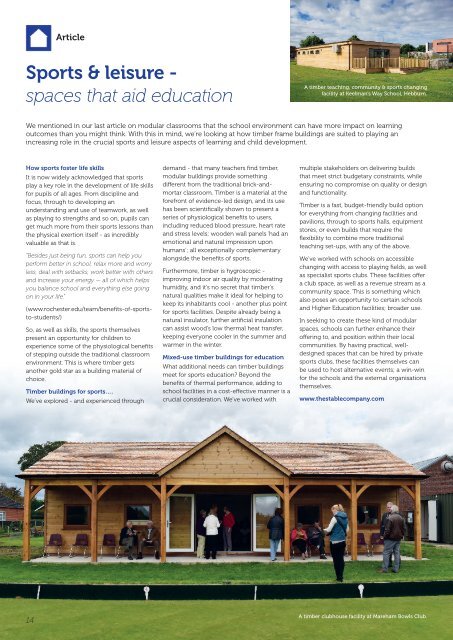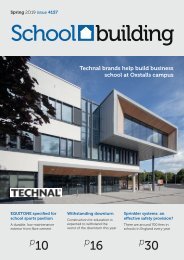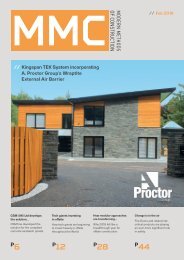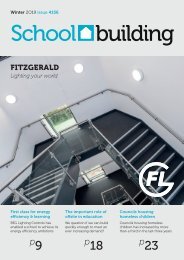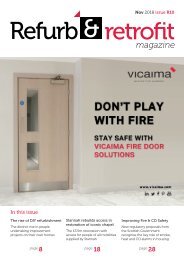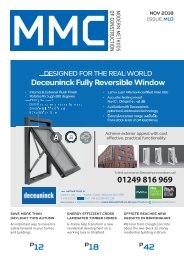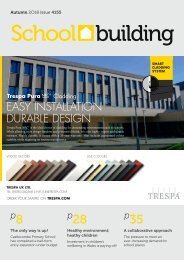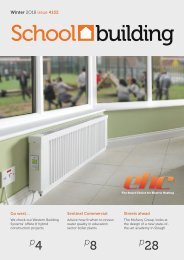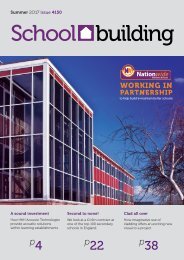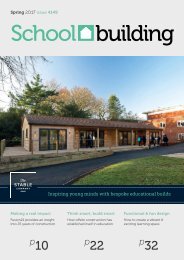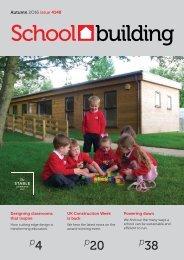SB 4154 Web
Create successful ePaper yourself
Turn your PDF publications into a flip-book with our unique Google optimized e-Paper software.
Article<br />
Sports & leisure -<br />
spaces that aid education<br />
A timber teaching, community & sports changing<br />
facility at Keelman’s Way School, Hebburn.<br />
We mentioned in our last article on modular classrooms that the school environment can have more impact on learning<br />
outcomes than you might think. With this in mind, we’re looking at how timber frame buildings are suited to playing an<br />
increasing role in the crucial sports and leisure aspects of learning and child development.<br />
How sports foster life skills<br />
It is now widely acknowledged that sports<br />
play a key role in the development of life skills<br />
for pupils of all ages. From discipline and<br />
focus, through to developing an<br />
understanding and use of teamwork, as well<br />
as playing to strengths and so on, pupils can<br />
get much more from their sports lessons than<br />
the physical exertion itself - as incredibly<br />
valuable as that is.<br />
“Besides just being fun, sports can help you<br />
perform better in school, relax more and worry<br />
less, deal with setbacks, work better with others<br />
and increase your energy — all of which helps<br />
you balance school and everything else going<br />
on in your life.”<br />
(www.rochester.edu/team/benefits-of-sportsto-students/)<br />
So, as well as skills, the sports themselves<br />
present an opportunity for children to<br />
experience some of the physiological benefits<br />
of stepping outside the traditional classroom<br />
environment. This is where timber gets<br />
another gold star as a building material of<br />
choice.<br />
Timber buildings for sports….<br />
We’ve explored - and experienced through<br />
demand - that many teachers find timber,<br />
modular buildings provide something<br />
different from the traditional brick-andmortar<br />
classroom. Timber is a material at the<br />
forefront of evidence-led design, and its use<br />
has been scientifically shown to present a<br />
series of physiological benefits to users,<br />
including reduced blood pressure, heart rate<br />
and stress levels; wooden wall panels ‘had an<br />
emotional and natural impression upon<br />
humans’; all exceptionally complementary<br />
alongside the benefits of sports.<br />
Furthermore, timber is hygroscopic -<br />
improving indoor air quality by moderating<br />
humidity, and it’s no secret that timber’s<br />
natural qualities make it ideal for helping to<br />
keep its inhabitants cool - another plus point<br />
for sports facilities. Despite already being a<br />
natural insulator, further artificial insulation<br />
can assist wood’s low thermal heat transfer,<br />
keeping everyone cooler in the summer and<br />
warmer in the winter.<br />
Mixed-use timber buildings for education<br />
What additional needs can timber buildings<br />
meet for sports education? Beyond the<br />
benefits of thermal performance, adding to<br />
school facilities in a cost-effective manner is a<br />
crucial consideration. We’ve worked with<br />
multiple stakeholders on delivering builds<br />
that meet strict budgetary constraints, while<br />
ensuring no compromise on quality or design<br />
and functionality.<br />
Timber is a fast, budget-friendly build option<br />
for everything from changing facilities and<br />
pavilions, through to sports halls, equipment<br />
stores, or even builds that require the<br />
flexibility to combine more traditional<br />
teaching set-ups, with any of the above.<br />
We’ve worked with schools on accessible<br />
changing with access to playing fields, as well<br />
as specialist sports clubs. These facilities offer<br />
a club space, as well as a revenue stream as a<br />
community space. This is something which<br />
also poses an opportunity to certain schools<br />
and Higher Education facilities; broader use.<br />
In seeking to create these kind of modular<br />
spaces, schools can further enhance their<br />
offering to, and position within their local<br />
communities. By having practical, welldesigned<br />
spaces that can be hired by private<br />
sports clubs, these facilities themselves can<br />
be used to host alternative events; a win-win<br />
for the schools and the external organisations<br />
themselves.<br />
www.thestablecompany.com<br />
14<br />
A timber clubhouse facility at Mareham Bowls Club.


